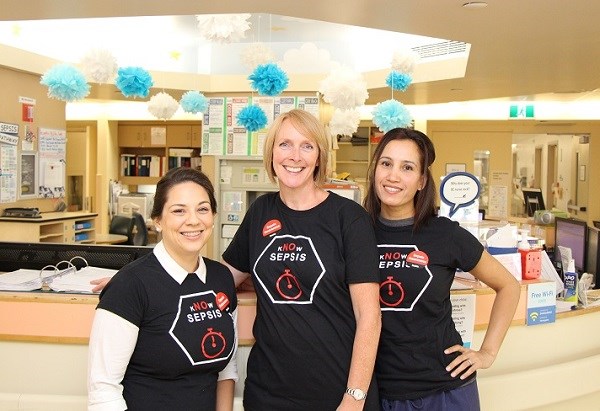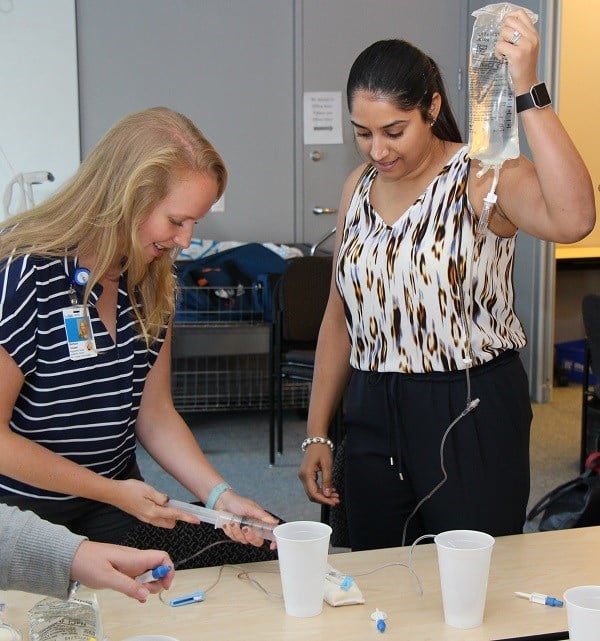Say the ‘S’ word! Using education and simulation to improve management of sepsis
Summary:
In recognition of World Sepsis Awareness Day, SickKids is highlighting how collaboration and innovation have contributed to the success of our inpatient sepsis recognition and management project.

You just need to spend a few minutes with Erin, Julie and Sandhaya to see how passionate they are about the inpatient sepsis recognition and management project they work on as a team. And it’s their passion, problem-solving skills and commitment to collaboration that has contributed to the success of this initiative.
In recognition of World Sepsis Awareness Day, Sept. 13, The Hospital for Sick Children (SickKids) is highlighting the progress we’ve seen on this project in the past year.
In keeping with the core focus of our Caring Safely initiative, eliminating harm to patients, we have zeroed in on the early recognition and management of sepsis more recently. In 2015 we implemented an effective screening tool in the Emergency Department that requires clinicians to screen for sepsis during the critical moment of triage. Between February and December 2016, 99.6 per cent of patients who came to SickKids for emergency care were screened for sepsis, exceeding the targeted 80 per cent noted on our Quality Improvement Plan (QIP). Now we’ve finished training over 1,000 staff in methods to improve the recognition and management of sepsis cases on the inpatient side.
The sepsis project is an example of our strategy, Building Connections, Accelerating Impact, at work and the team has embodied our core values of collaboration and innovation. Building effective relationships with each unit has been key in helping the team to accelerate their impact.
“Collaboration has been a guiding principle for our work. It’s impossible to even imagine pulling off this kind of project without multiple levels of leadership and pillars across the organization engaged,” says Erin Vandeven, Professional Practice Coordinator and Project Lead for the sepsis pathway project.
While it’s important to have a consistent approach to sepsis across the hospital, the team quickly recognized the need for local customization. Erin, Julie and Sandhaya met with educators, managers and quality leaders on each unit to present their implementation model, leaving space for unique communication and touch points, depending on the culture and practices of the unit.
“I think one of the reasons we’ve seen such progress is the approach we have to working with units and recognizing, up front, there are multiple pressing priorities in the hospital, and sepsis is just one of them,” says Erin.
The tools and education leverage the Caring Safely behaviours and attitudes.
“We really encourage everyone to verbalize the word sepsis if you’re raising a concern, which helps the situational awareness of other members of the health-care team. The SBAR communication tool is also embedded in the pathway; it’s a useful tool to clearly communicate your action plan,” says Sandhaya Parekh, Interprofessional Education Specialist, 8C and Education Lead for the project.
The sepsis inpatient education program was designed in collaboration with the Learning Institute and includes four elements: a case study review, which is always designed to the local context of the nurses that are learning; two simulations, one focusing on recognition, the other on management; hands-on skills stations to practice administering antibiotics and fluid resuscitation (bolus); and an e-learning module to refresh knowledge.

“The Learning Institute really provided us with the backbone for developing robust, reliable simulations. They employed the diamond debriefing model at SickKids for the first time that guides effective debriefing for simulation in large groups and engages observers so they’re actively learning as well,” says Julie Watson, Nurse Practitioner, 8A and Clinical Lead for the project.
Part of the education is teaching the pathway, but it has to be paired with building confidence.
“The management pathway is black and white, but what happens before that can be a long trajectory to come to the decision to activate it. Getting to that decision is hard, but we’re encouraging staff to say the ‘S’ word, to say sepsis,” says Erin.
Looking ahead to 2018, the team plans to further engage families and develop education and information materials geared to them. They’re also working closely with the Epic project to build triggers and practice alerts for sepsis into the new health information system.
For now, they will continue to focus on educating and coaching staff across the inpatient units at SickKids. The goal is to train 80 per cent of the eligible nursing staff by December, and they are well on track to achieving their goal.

